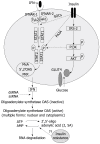Targeting host factors: a novel rationale for the management of hepatitis C virus
- PMID: 19630100
- PMCID: PMC2715971
- DOI: 10.3748/wjg.15.3472
Targeting host factors: a novel rationale for the management of hepatitis C virus
Abstract
Hepatitis C is recognized as a major threat to global public health. The current treatment of patients with chronic hepatitis C is the addition of ribavirin to interferon-based therapy which has limited efficacy, poor tolerability, and significant expense. New treatment options that are more potent and less toxic are much needed. Moreover, more effective treatment is an urgent priority for those who relapse or do not respond to current regimens. A major obstacle in combating hepatitis C virus (HCV) infection is that the fidelity of the viral replication machinery is notoriously low, thus enabling the virus to quickly develop mutations that resist compounds targeting viral enzymes. Therefore, an approach targeting the host cofactors, which are indispensable for the propagation of viruses, may be an ideal target for the development of antiviral agents because they have a lower rate of mutation than that of the viral genome, as long as they have no side effects to patients. Drugs targeting, for example, receptors of viral entry, host metabolism or nuclear receptors, which are factors required to complete the HCV life cycle, may be more effective in combating the viral infection. Targeting host cofactors of the HCV life cycle is an attractive concept because it imposes a higher genetic barrier for resistance than direct antiviral compounds. However the principle drawback of this strategy is the greater potential for cellular toxicity.
Figures



Similar articles
-
Treating hepatitis C infection by targeting the host.Transl Res. 2012 Jun;159(6):421-9. doi: 10.1016/j.trsl.2011.12.007. Epub 2012 Jan 10. Transl Res. 2012. PMID: 22633094 Free PMC article. Review.
-
Development of novel antiviral therapies for hepatitis C virus.Virol Sin. 2010 Aug;25(4):246-66. doi: 10.1007/s12250-010-3140-2. Epub 2010 Jul 28. Virol Sin. 2010. PMID: 20960299 Free PMC article. Review.
-
Therapy of chronic hepatitis C virus infection in the era of direct-acting and host-targeting antiviral agents.J Infect. 2014 Jan;68(1):1-20. doi: 10.1016/j.jinf.2013.08.019. Epub 2013 Sep 4. J Infect. 2014. PMID: 24012819 Review.
-
Hepatitis C virus entry into hepatocytes: molecular mechanisms and targets for antiviral therapies.J Hepatol. 2011 Mar;54(3):566-76. doi: 10.1016/j.jhep.2010.10.014. Epub 2010 Nov 11. J Hepatol. 2011. PMID: 21146244 Review.
-
Entry inhibitors: New advances in HCV treatment.Emerg Microbes Infect. 2016 Jan 6;5(1):e3. doi: 10.1038/emi.2016.3. Emerg Microbes Infect. 2016. PMID: 26733381 Free PMC article. Review.
Cited by
-
Effect of vitamin D therapy on interleukin-6, visfatin, and hyaluronic acid levels in chronic hepatitis C Egyptian patients.Ther Clin Risk Manag. 2015 Feb 19;11:279-88. doi: 10.2147/TCRM.S66763. eCollection 2015. Ther Clin Risk Manag. 2015. PMID: 25737638 Free PMC article.
-
The Amino Acid Substitution Q65H in the 2C Protein of Swine Vesicular Disease Virus Confers Resistance to Golgi Disrupting Drugs.Front Microbiol. 2016 Apr 27;7:612. doi: 10.3389/fmicb.2016.00612. eCollection 2016. Front Microbiol. 2016. PMID: 27199941 Free PMC article.
-
The myxobacterial metabolite ratjadone A inhibits HIV infection by blocking the Rev/CRM1-mediated nuclear export pathway.Microb Cell Fact. 2014 Jan 29;13:17. doi: 10.1186/1475-2859-13-17. Microb Cell Fact. 2014. PMID: 24475978 Free PMC article.
-
Fungus-Derived Neoechinulin B as a Novel Antagonist of Liver X Receptor, Identified by Chemical Genetics Using a Hepatitis C Virus Cell Culture System.J Virol. 2016 Sep 29;90(20):9058-74. doi: 10.1128/JVI.00856-16. Print 2016 Oct 15. J Virol. 2016. PMID: 27489280 Free PMC article.
-
Anti-hepatitis C virus activity and toxicity of type III phosphatidylinositol-4-kinase beta inhibitors.Antimicrob Agents Chemother. 2012 Oct;56(10):5149-56. doi: 10.1128/AAC.00946-12. Epub 2012 Jul 23. Antimicrob Agents Chemother. 2012. PMID: 22825118 Free PMC article.
References
-
- World Health Organization. Hepatitis C. Fact sheet number 164. Available from: URL: http://www.who.int/mediacentre/factsheets/fs164/en/
-
- Medhat A, Shehata M, Magder LS, Mikhail N, Abdel-Baki L, Nafeh M, Abdel-Hamid M, Strickland GT, Fix AD. Hepatitis c in a community in Upper Egypt: risk factors for infection. Am J Trop Med Hyg. 2002;66:633–638. - PubMed
-
- Habib M, Mohamed MK, Abdel-Aziz F, Magder LS, Abdel-Hamid M, Gamil F, Madkour S, Mikhail NN, Anwar W, Strickland GT, et al. Hepatitis C virus infection in a community in the Nile Delta: risk factors for seropositivity. Hepatology. 2001;33:248–253. - PubMed
-
- Lauer GM, Walker BD. Hepatitis C virus infection. N Engl J Med. 2001;345:41–52. - PubMed
-
- NIH Consensus Statement on Management of Hepatitis C: 2002. NIH Consens State Sci Statements. 2002;19:1–46. - PubMed
Publication types
MeSH terms
Substances
LinkOut - more resources
Full Text Sources
Other Literature Sources

